|
 Christmas Christmas
History and fables are plentiful as to the most
magical feast of all time. Christmas constitutes
the biggest feast of Christianity and is
celebrated throughout the centuries, based on
various customs and depending on the folklore
deliveries of various Christian populations. The
celebration of Christmas until today evokes and
rekindles feelings of love, solidarity and
humanity, which is also the message that was
brought to us by the birth of Christ. |
|
|
|
 December
25th - The Day of
Celebration of Christmas December
25th - The Day of
Celebration of Christmas
Because the first Christians were outlawed in
Rome - they were not allowed to meet in churches
- they gathered in catacombs where their
religious feasts took place. The persecutions
that existed were terrible. Thus, they decided
to celebrate Christmas on December 25th, the
period when the Romans were occupied with the
Saturnalia. December 25th was established as a
day of celebration of Christmas for the first
time in Rome, roughly in the middle of the 4th
century A.D. During the period of the Justinians,
in the 6th century, the celebration of Christmas
on December 25th expanded to almost the entire
East. |
|
|
|
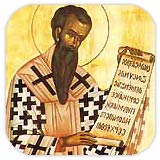 Saint Vasilis (St. Basil) Saint Vasilis (St. Basil)
"...Ai Vasilis comes from Caesarea..."
The Greek
popular Christmas carol correctly determines the
place of origin of Saint Vasilis (Ai Vasilis),
who has become a world symbol of love and
offers, and thanks to this the people of the
world have the opportunity to show mercy and
charity and the children of world "to see" their
wishes turn into reality. Thanks to Saint
Vasilis, all of humanity for a few days changes
style, becoming more
human, more cheerful. Therefore Ai Vasilis
EXISTS with the significance that, even if he
does not live in body,
his spirit surrounds our hearts each Christmas
and New Year. The fable of Ai Vasilis and Santa
Claus on our
planet, with the distribution of gifts to
children, paradoxically involves two Orthodox
Saints, two different
persons, but both of whom were also bishops and
of Christian origin. For the countries of the
West the one that
brings the gifts to the poor and the children is
Saint Nikolaos (Nichlaus) or Santa Claus, whom
we honour and
celebrate in Greece on 6 December and consider
him the protector of seamen. In the history of
Saint Nikolaos as
protector of the poor and the children, the
populations of the north (Netherlands, Finland,
etc.) combined bits
and pieces from ancient fables, such as the
northern stars, the sleigh, etc. Thus, with the
passing of time the
fable of Saint Vasilis also reached our country,
namely the plump man with round glasses and
white beard, with
a red uniform and magic abilities that lives in
the North Pole and is surrounded by snow
fairies. It is a
really enchanting story. Ai - Vasilis with the
gifts does not only limit himself to the narrow
confines of
Christianity, for we see him exceed his power
and conquer the hearts of all persons worldwide.
The custom with
the gifts of Saint Vasilis is the most popular
of all over the entire New Year celebrations,
especially for the
children that impatiently wait for the gifts! |
|
|
|
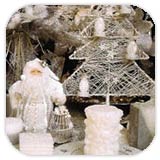 Traditional Christmas Customs Traditional Christmas Customs
The superstitious habits of people from older
days still prevail today, with many of them
based on health
reasons. One of the habits is for Greeks to wear
new clothing for good luck when the New Year
comes and to
return whatever borrowed, again for good luck.
From Christmas to Theofania (Epiphany Day)
people are not
supposed to wash their hair, as they wait for
the waters to be blessed on Theofania. They wait
for Christmas
and New Year's as it is a time when they break
their 40-day fasting. In the villages, youth
gather with their
musical instruments and make Christmas Eve
visits to homes to sing and play carols. The
Christmas carols are
many and each region of Greece has its own. |
|
|
|
 The Carols The Carols
"Shall we sing them?"
"Yes, sing them, sing them!"
This is the characteristic question by the
children who knock on each door offering to sing
the carols, whether
they are for Christmas, for the New Year or for Theofania. Hundreds of groups of children spill
into the
streets of villages, towns and cities throughout
Greece, some holding musical instruments and
others with
musical triangles and drums, asking homeowners
whether they can sing them the carols. At the
end, the carol
singers are rewarded with either money or
sweets. This is another tradition that has been
carried down from
generation to generation and is still found
today throughout the land. The word "kalanda"
(carols) emanates
from the Latin "calenda" which means the start
of the month. The custom of singing carols
pre-existed in Greece
even before the Roman era. The carols have their
base in old popular songs and the lyrics wish
the home owner
and his family good health and fortune in the
New Year. In various parts of the country, both
on the mainland
and on the islands, the carols are performed in
different ways. |
|
|
|
 The Turkey The Turkey
In Europe an old tradition is the cooking of a
large bird for the holiday dinner. Pheasants,
geese and peacocks
were preferred. However, when the turkey was
tried it became established as the most
prominent and preferred
Christmas dinner. At the beginning of the 19th
century in Norfolk, England, the poultry farmers
resolved the
problem of transporting turkeys as follows: they
made the birds walk more than 100 kilometres in
one week to
cover the distance up to the capital. And
because their legs are not made for walking long
distances, they wore
special covers or soaked their legs in tar in
order to harden them! In Peru, the beloved food
is the charcoal-
broiled heart of a bull, with a lot of spices
and vinegar. |
|
|
|
 The Christmas Tree The Christmas Tree
How "Greek" is the Christmas tree?
When, how and why was the Christmas tree used as
a symbol? In the 4th century A.D., December 25th
was
established as the day of the Birth of Christ
and simultaneously as the first day of time.
However, there exist
testimonies that Christmas was celebrated in
Rome on December 25th since 336. The tree, as a
Christmas symbol,
was used after the 8th century. The person who
established the first Christmas tree was,
according to
tradition, Agios (Saint) Vonifatios, who
introduced the fir as a symbol of Christianity
and more specifically
as the symbol of Christmas. Naturally, through
the passage of time, the meaning of the
Christmas tree took
numerous forms. And initially, in order for it
to symbolize the joy that is hidden in each
person for the birth
of Christ, it began to be filled with various
ornaments, mainly foodstuff and clothing,
symbolizing the offer
of Divine Gifts. In England Charles Dickens, the
writer of the holiday season, took the Christmas
spirit
further. And today the Christmas tree as we know
it around the world is owed to Charles Dickens,
who in his
various Christmas stories brought us closer to
that holiday spirit. His well-known "A Christmas
Carol" brings
us directly to the symbol of Christmas and the
Christmas tree. In Greece, the Christmas tree
was brought for
the first time by the Bavarians, when the
Bavarian royal family was introduced to help
rule the country upon
the establishment of its independence in the
1830's. The first public Christmas tree was
decorated in the Royal
Palace in 1833 in Athens. Since World War II the
tree with its colorful bulbs had entered all
Greek homes. As
mentioned earlier, the Christmas tree was
presented for the first time in Germany at the
end the 16th and start
of the 17th century. Until the start of the 19th
century it was not widely known - as Christmas
trees were
placed only in the churches. Sometimes the
churches imposed the payment of an admission
ticket for those who
wanted to see the tree. The tree symbolizes the
life that "dies" in the winter. In the past in
Greece, a ship
was often the symbol of Christmas and they
embellished the squares in each city and every
corner of the Greek
territory. |
|
|
|
 The Christmas Bread - A
Custom of Crete The Christmas Bread - A
Custom of Crete
The Christmas bread is made by women, employing
considerable care and patience. The kneading of
the dough
resembles a ritual. They use expensive materials
(very fine flour, rosewater, honey, sesame,
cinnamon, and
carnations). They mould the dough and take half
of it to make biscuits (koulouria). With the
rest they make
crosses with strips from the dough. In the
centre the women then put unbroken walnuts. On
the rest of the
surface they draw figures with a knife or fork,
such as flowers, leaves, fruits and birds. The
Christmas bread
is blessed for the Christmas table. They cut it
the day before Christmas, making wishes at the
same time. On
Christmas Day, the owner of the house cuts
slices of the bread for all the family.
Ingredients:
4 1/2 cup semolina flour
2 1/4 cup sugar
3 Tbs. freshly ground
cinnamon
1 Tbs. freshly ground anise
1 Tbs. freshly ground
coriander |
2 tsp. freshly ground cloves
3 oranges
6 tangerines
2 1/2 cup dried currants
1 cup golden raisins
1 cup olive oil, mild |
Starter Dough:
4 pkg active dry yeast
1/2 tsp. sugar hot water,
(just above body temp)
4 cup all-purpose flour
(plus extra for kneading) |
Instructions:
Make the flavoring addition first.
Combine the semolina flour, sugar,
cinnamon, anise, coriander, and cloves
in a bowl and add the finely grated
zests of the oranges and tangerines.
Squeeze some of the oranges and
tangerines. Squeeze some of the oranges
and tangerines to obtain 1 1/4 cups
juice. Use half this juice to soak the
currants and raisins for a minimum of 1
hour, preferably overnight. Put the
remaining juice in a pan with the olive
oil. Heat until almost boiling. Pour
this into a bowl with the semolina and
spice mixture and stir. Cover and leave
overnight until needed.
Next day, combine the dried yeast with
the sugar and hot water in a cup. Put
the flour in a bowl, making a well in
the center. Pour in the yeast mixture.
Squeeze 2/3 cup more orange and
tangerine juice, warm it, nad add. Work
to a smooth dough, adding more water and
warm juice if necessary. Put the dough
into an oiled bowl, cover with a cloth,
and leave to rise in a warm place until
almost doubled in size - about an hour.
Punch down the dough in a bowl. Combine
the drained currants and raisins with
the semolina and spice mixture and,
working with your hands, combine with
the dough. Turn the dough onto a floured
surface and knead for 10 minutes, adding
more flour if the dough is sticky.
Divide the dough into three equal
pieces. Oil 3 loaf pans, each 1-1/2
quart capacity. Shape each piece to fit
the length of the pan and fit them in,
so the corners are well filled. Cover
with a cloth and leave to rise in a warm
place until almost double in size -
another hour.
Bake in an oven preheated to 350 F for 1
hour and 10 minutes or more; the loaves
should be rich brown color and make a
hollow sound when the unmolded bread is
thumped on the bottom. Leave on a rack
to cool. The bread will keep for at
least 3 weeks. |
|
|
|
|
 The Fir Tree The Fir Tree
It was prominent in Germany and Scandinavia and
expanded throughout the world until it became
essential as a
representation of Christmas. Besides the
brilliant bulbs and lights, there are also other
ideas from around the
world for decorating the Christmas tree. In
Lithuania, for example, a spider and her web is
placed on the tree.
This is based on a legend which says that this
had once been made by a poor woman as her
children slept. When
the kids woke up, on Christmas Day, they are
said to have found the tree with the golden webs
shinning. In
Czechoslovakia the tree is embellished with dyed
egg shells and in the USA with festoons from
pop-corn.
Elsewhere, they hang horns of animals and bells
in order to frighten away the mean spirits. In
the past they
put lit candles on the firs. That custom led to
a lot of accidents! Thus, until the invention of
electric bulbs
and for obvious reasons they also had a bucket
of water under the tree, to counter the danger
of fires... |
|
|
|
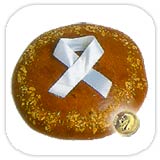 Vasilópita - Traditional New Year's Cake Vasilópita - Traditional New Year's Cake
Vasilópita is a sweet nut cake with a coin
hidden inside, traditionally served on New
Year's Eve, when families honor St. Vasilios
(Santa Claus), who comes down to earth on that
day. Vasilópita can be made as a Madeira sponge
or a puff pastry cake with nuts, or in a
savory version with meat. A coin is hidden
inside the cake after baking, and the cake is
cut on New Year's Eve, with all the family
present. The pieces are distributed in a
predetermined order: the first is for Christ,
the second for Mary, the third is for St. Vasilios, the fourth for the house, the fifth
for the head of the family, the sixth for the
mother, then one for each of the children. A
piece is also cut for each absent member of the
family. Whoever finds the coin can look forward
to special success in the coming year.
The cutting of the New Year cake or vasilópita
is one of the few old customs that survive
today. In antiquity
there existed the custom of the festive bread
that in major rural feasts the ancient Greeks
offered to the
gods. Such feasts were the Thalisia and the
Thesmoforia. In Kronia (the feast of the god
Chronos), that was
worshipped in Greece and in the saturnalia of
Rome, they also made pies in which they put
currencies and the
winner of the currencies was then supposed to
have good luck... The Orthodox tradition
connected the custom
with the New Year cake. The history of vasilópita
began roughly 1,500 years ago, in the city
Caesarea of Kappadokias, in Asia Minor (western
Turkey today).
The Great King was despot of Caesarea and lived
harmoniously with his fellow men, with love,
understanding and
mutual help. One day however, a hungry general -
tyrant of the region asked him for all the
treasures of the
city of Caesarea, threatening that otherwise he
would besiege the city to conquer and plunder
it. Throughout
the entire night the Great King prayed for God
to save the city. At dawn the general decided to
encircle
Caesarea. He entered with his army and asked to
see the Despot, who was found in the temple
praying. With
audacity and anger the unscrupulous general
demanded the gathering of the gold of the city
as well as other
precious items that existed. The Great King
answered that the people of his city did not
have anything other
than hunger and that they did not have anything
to give to the general. But the general upon
hearing the
message demanded even more and threatened the
king. The Christians of Caesarea loved their
Despot and wanted to
help him. They therefore gathered from their
houses whatever gold they had and offered it to
him. The general
was furious and ordered his soldiers to attack
the city. The Great King gathered all the gold
that was offered
by the citizens and presented them to the
general in order to save his city from a
massacre. However, the
moment the general opened the treasures a
miracle occurred. All assembled saw a bright
burst of light followed
by a brilliant rider dashing above the general
and his army. Within a short time, the general
and his army
disappeared. The rider was Aghios Merkourios and
the soldiers were his angels. Thus, the city of
Caesarea was
saved. Then, however, the despot found himself
in a difficult position! How was he to share the
gold with the
residents of the city and distribute it fairly?
It was a very difficult task indeed. After
praying, the Great
King was given divine guidance and he called on
his aides to bake small loaves of bread and
place some gold
coins inside each one of them. The surprise for
the residents came when they were distributed
the bread and
they found gold coins inside for them to keep.
This later turned into a New Year celebration
which we still
find today, with each Greek family cutting the
vasilópita cake which contains a coin and which
will bring luck
to the person who finds it.
Click
here for the recipe (featured in our
January 2007 newsletter)... |
|
|
|
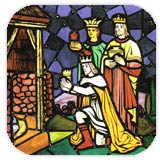 The Wise Men, and Just How Many They Were The Wise Men, and Just How Many They Were
Tradition at time calls for two or more Wise
Men. The established number nowadays is the
three that were first
mentioned by Pope Leon in the fifth century. He
determined this number from the three gifts
given to baby
Jesus: the gold, the incense and the smyrna. The
Wise Men are: Balthazar, Jasper, and Mahler. In
their
depictions Jasper is the old man with the beard
and is almost always first to present his gift;
Mahler is
always young and without a beard and comes
second, while Balthazar is portrayed as always
very dark-skinned or
black and comes third in line. |
|
|
|
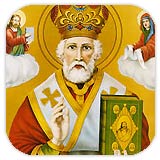 "Santa Claus" and the Exchange of Gifts "Santa Claus" and the Exchange of Gifts
The exchange of gifts began during the Roman
feasts. The Romans gave gifts to each other as
well as to the
poor. The modern symbol of commercialisation of
Christmas is Santa Claus, who is erroneously
compared in modern
Greece with Agios (Saint) Vasilis. The
"genealogical" origin of Western-made Santa
Claus is Agios Nikolaos
(Saint Nichlaus), the Bishop of Myronos-Avkias
of the 4th century A.D., who was known for his
virtue and his
charity and as the guardian angel of children
and seamen. |
|
|
|
 New Year's Customs and Superstitions New Year's Customs and Superstitions
In the beautiful Eptanisa islands, between the
Ionian and Adriatic seas, the 12 days leading to
Christmas are
celebrated with church-going, eating, dancing,
singing but also with the sharing of jokes.
The Kolonies (perfumes): On New Year's
Eve, the
residents fill the streets spraying one another
with perfumes,
wishing them well for the New Year. Another
celebration of the New Year in old Athens found
homeowners laying
out a table with food and pastries outdoors so
that the tired and hungry Agios Vasilis (father
Christmas) can
enjoy himself after all his travels. At midnight
the lamps were turned off (to drive away evil
from the past
year), and turned on again (to bring in the New
Year with good luck). In addition, an old shoe
is thrown into
the street, again signifying the end of the
"bad" past. Then the family sits down for food
and drinks which
took them well into the early morning hours. The
custom of the pomegranate is maintained in many
villages, as
with the turn of the New Year the pomegranate
(the symbol of abundance, fertility and good
luck), which is hung
outside the door, is broken open and the
inhabitants then enter the house placing their
right foot first for
good luck. The children hang up their shoes and
socks in the windows or above the fireplace,
waiting for Agios
Vasilis to fill them with gifts. In the Cycladic
islands, it is considered a good omen if the
wind blows from
the north on New Year's Day. It is also
considered a good omen if a pigeon comes into
their courtyard. It is a
bad omen, however, if the pigeon flies above
their home, as it purportedly means that
disaster awaits them. The
New Year brings in a lot of superstition as
people will avoid paying debts, lending money,
and working, or even
lighting someone's cigarette. All this comes
from the belief that whatever is done on that
day will have the
same consequences throughout the year. |
|
|
|

